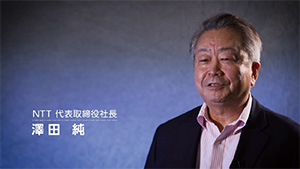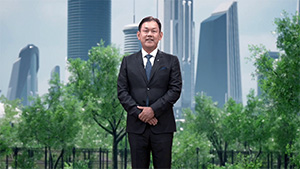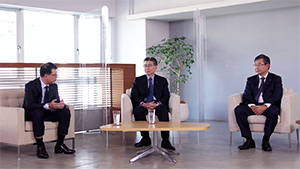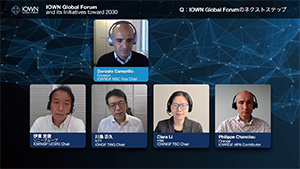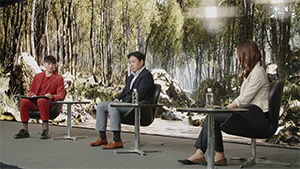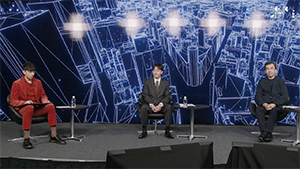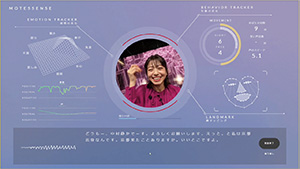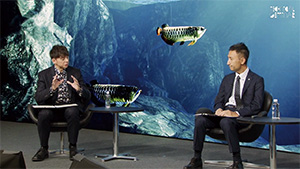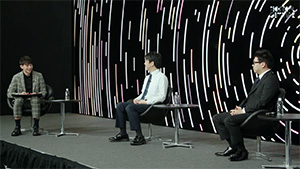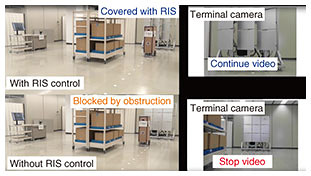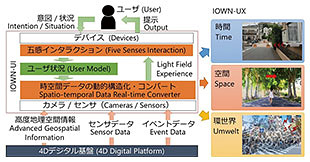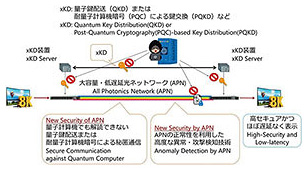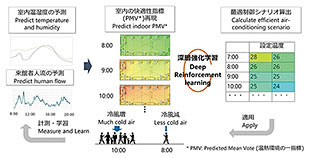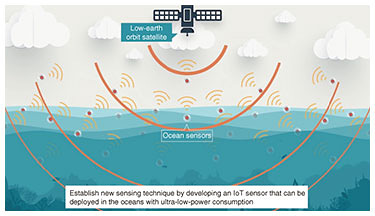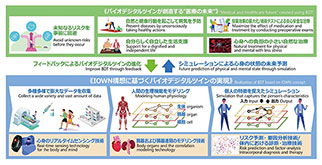 |
|
|
|
|
|
Information Vol. 20, No. 2, pp. 84–92, Feb. 2022. https://doi.org/10.53829/ntr202202in1 Report on NTT R&D Forum—Road to IOWN 2021AbstractNTT R&D Forum—Road to IOWN 2021 was held online over a four-day period from November 16th to 19th, 2021. This article is an introductory overview of the Forum. Keywords: R&D forum, IOWN, technical seminar 1. Forum overviewThe NTT R&D Forum introduces the latest efforts by NTT laboratories every year. This year, 97 exhibits were held in six categories based on the concept of “Road to IOWN 2021,” and 10 lectures/seminars were streamed as an accessible introduction to the present status of the Innovative Optical and Wireless Network (IOWN) initiative in which the NTT Group as a whole is engaged. 2. Keynote speeches/special sessions2.1 Keynote Speech 1Jun Sawada, President and CEO of NTT, spoke on the theme “What is IOWN?” (Photo 1). First, President Sawada presented the importance of “Umwelt” (environment or surroundings) in the midst of natural disasters and a pandemic unexpected in traditional naturalism, and the significance of IOWN as a “media connecting different Umwelten.” President Sawada introduced three demonstration experiments as IOWN use cases, including the “Avatar Robot Café DAWN,” which provides a place for people with disabilities to work via the Internet and technology. In addition, the roadmap for IOWN introduction and research and development (R&D) through 2030 for photonics-electronics converged devices was presented, with the aim of implementing optical materials between chips by 2025, and both between chips and within chips by 2030. The new NTT Group Environment and Energy Vision of “NTT Green Innovation toward 2040” was also introduced, simultaneously working to achieve the contradictory aims of “solving environmental problems” and “economic growth” through reducing environmental impact and creating innovation that breaks limits through business activities. Under the NTT Group philosophy of “Self as We,” which aims for altruistic coexistence, the company has declared that it will continue to work on three themes: “Ensuring the coexistence of nature and humanity,” “Improving prosperity for all people and cultures” and “Maximizing well-being for all,” aiming for the realization of a sustainable society. For more information, see the article entitled “What is IOWN?” in this issue.
2.2 Keynote Speech 2Katsuhiko Kawazoe, Executive Vice President, Head of Research and Development Planning, NTT, gave a lecture on the theme of “Road to IOWN 2021” (Photo 2). The IOWN concept, which began with the invention of optical transistors at one NTT research laboratory, now extends beyond the entire NTT Group to operations worldwide. In his speech, Executive Vice President Kawazoe reported on the progress of the technological developments that make up the IOWN concept, which was announced in May 2019 and is now in its third year, and introduced 15 leading innovative technologies. In addition, he reported that the number of members of the IOWN Global Forum has increased to approximately 80 in less than two years. He also noted the establishment of the NTT IOWN Integrated Innovation Center on July 1, 2021 to accelerate R&D toward realizing IOWN, and the NTT R&D Authority Team, which includes prominent executives and researchers in each field. For more information, see the article entitled “Road to IOWN 2021” in this issue.
2.3 Special Session 1Masahisa Kawashima, Vice President, Head of IOWN Development Office, moderated a discussion between the new leaders of the organization, titled “New R&D leaders talk about steps toward the realization of IOWN” (Photo 3). Hidehiro Tsukano, Senior Vice President, Head of IOWN Integrated Innovation Center, which was established in July 2021 in order to realize the core technologies of IOWN, is from Fujitsu, the supplier side. In addition, Tomoyoshi Oono, Senior Vice President, Head of Service Innovation Laboratory Group, which aims to create a society in which all people can live in a state of well-being by utilizing Digital Twin Computing (DTC), was involved with service creation in the R&D department of NTT DOCOMO. In this session, opinions were exchanged on issues such as how IOWN will be used to create markets and what activities to proceed with in the future. In response to the question, “What is necessary for global vendors to participate in IOWN?” Senior Vice President Tsukano pointed out the importance of standardization through the IOWN Global Forum, and Senior Vice President Oono pointed out the importance of partners who create services together.
2.4 Special Session 2This IOWN Global Forum members’ session was held on the theme of “IOWN Global Forum and its Initiatives Toward 2030” (Photo 4). The four participants were Gonzalo Camarillo, Vice Chair of the Marketing Steering Committee, who served as the moderator; Clara Li, member of the IOWN Global Forum and chair of the Technology Steering Committee; Philippe Chanclou, contributor to IOWN Global Forum activities related to the All-Photonics Network; Katsutoshi Itoh, Chair of the Use Case Working Group; and Masahisa Kawashima, Vice President, Head of IOWN Development Office and Chair of the Technology Working Group. Each panelist spoke about the current situation and challenges in their own field of expertise, on themes such as “the relationship between the IOWN Global Forum and other standards organizations” and “the social benefits of IOWN.” Regarding the social benefits of IOWN, Vice President Kawashima pointed out the contribution to energy efficiency, Dr. Itoh spoke on improved operational efficiency through modeling, and Dr. Li noted the contribution of building a Data Centric Infrastructure (DCI) to energy efficiency and sustainability.
3. Technical seminarsThe streaming technical seminars provided an introduction to the latest results from research that NTT is currently engaged in, as well as a discussion with guests. This year, seminars were streamed on six themes: “Application of ICT technology to agriculture and prospects for the future,” “Trusted dataspace: To overcome the barrier of cross-domain data sharing,” “New era in AI: Think and grow like humans - Next generation media processing AI ‘MediaGnosis™’,” “New user experiences through the interplay of the real and cyber space,” “New relationship between humans and the earth pioneered by blue carbon technology” and “The future pioneered by networking optical lattice clocks.” Here we present an overview of each seminar. 3.1 Technical Seminar 1The seminar was held by Hiroshi Yamamoto, Senior Research Engineer, Supervisor at NTT Network Service Systems Laboratories, under the title “Application of ICT technology to agriculture and prospects for the future.” Television personality Harry Sugiyama served as MC and Kei Kawana, founder of Neighbor’s Farm, was invited as a guest (Photo 5). “Smart Agri,” one of the six priority areas for NTT Group efforts to resolve social issues, was discussed in this session under the theme of “Networks and the Agricultural Environment.” The seminar introduced level 3 robotic agricultural machinery currently being jointly researched with Hokkaido University, and topics concerning improving availability, multi-layered safety measures and general-purpose platform development. Ms. Kawana, who runs a farm founded in Tokyo in 2018 as the first new farmer under the Act on Urban Farmland Lease Facilitation, expressed her hope that “significant levels of automation will be implemented while I am still working in this field, and that agriculture will grow into an attractive industry for the following generations.”
3.2 Technical Seminar 2The seminar, titled “Trusted dataspace: To overcome the barrier of cross-domain data sharing,” was held by Daigoro Yokozeki, Executive Research Engineer at NTT Social Informatics Laboratories. Television personality Harry Sugiyama served as MC and Noboru Koshizuka, Professor, Interfaculty Initiative in Information Studies, The University of Tokyo, was invited as a guest (Photo 6). Prof. Koshizuka established the Data Society Alliance (DSA), and is working with governments, industry associations, and NTT with the aim of “creating an environment for the free distribution of data.” The seminar introduced the concept of a “trusted data space for cross-domain information distribution” that can be used to provide and share the minimum amount of information to the minimum number of parties while remaining encrypted. In addition, the three elemental technologies of “high-performance encryption,” “secure computation AI” and “next-generation data hubs” were explained by engineers having expert knowledge in each field.
3.3 Technical Seminar 3The seminar, on the topic of “New era in AI: Think and grow like humans - Next generation media processing AI ‘MediaGnosis™’,” was held by Senior Research Engineer and Supervisor Yoshinori Kusachi and Distinguished Researcher Ryou Masumura, both from NTT Computer and Data Science Laboratories. Television personality Harry Sugiyama served as MC, and the actress Shizuka Nakamura was invited as a guest. At the seminar, Ms. Nakamura experienced “MOTESSENSE™,” which helps everyone discover their own charming individuality, as an example of an artificial intelligence (AI) that thinks and is capable of growth like a human. It pointed out that her “charm factor” or personal appeal was “emotion,” and she was surprised at the detailed diagnosis (Photo 7). Afterward, there was an introductory overview of “MediaGnosis™,” which is used in MOTESSENSE™. This aims to integrate all media information into “Gnosis” in the style of human knowledge, and then to make a “Diagnosis” based on it.
3.4 Technical Seminar 4This seminar featured television personality Harry Sugiyama as MC, with Naotaka Fujii, CEO of Hacosco Inc., and Michimasa Uematsu, Senior Executive Officer, CTO, ACCESS Co., LTD. as guests. The seminar was conducted under the title of “New user experiences through the interplay of the real and cyber space,” by Takeshi Yagi, Director, Research and Development Planning Department, NTT, and Shinji Fukatsu, Senior Research Engineer and Supervisor at NTT Human Informatics Laboratories (Photo 8). When low power consumption, broadband bandwidth, and low latency are realized, users can receive all information and choose from it freely depending on their intentions. During the seminar, user interface (UI) and user experience (UX) experts discussed what UI and UX should be like in the IOWN era, and what the UX should be if real and cyber space are intertwined through the 4D digital platform™.
3.5 Technical Seminar 5Television personality Harry Sugiyama served as MC at this seminar, with guests Kouji Kinjyo, CEO of Sea Seed Co., Ltd., a company working on coral cultivation and transplantation, and Karibu Suzuki, CEO of Karibu Collaboration Co., Ltd. and collector and researcher of juvenile fish. The seminar was conducted on the theme of “New relationship between humans and the earth pioneered by blue carbon technology” by Katsuhiko Okazaki, Senior Research Engineer and Supervisor at NTT Space Environment and Energy Laboratories (Photo 9). The focus of this year was NTT Space Environment and Energy Laboratories, which tackles environmental and energy issues from a space perspective. This time, the focus was on carbon dioxide (CO2) issues with the keyword “blue carbon.” Among the carbon absorbed by the global ecosystem, the carbon absorbed into the marine ecosystem is known as blue carbon, and carbon absorbed by shallow seas accounts for 35% of CO2 absorbed on the Earth. At the seminar, a lively discussion was held, with the introduction of joint research between Regional Fish Institute, Ltd., a venture company originating from Kyoto University, and NTT.
3.6 Technical Seminar 6Television personality Harry Sugiyama served as MC for this seminar, with guests Hidetoshi Katori, Professor, Department of Applied Physics, Graduate School of Engineering, The University of Tokyo, and Tetsuya Ido, Director, Space-Time Standards Laboratory, Radio Research Institute, National Institute of Information and Communications Technology. The seminar was held by Tomoya Akatsuka, Senior Research Scientist, NTT Basic Research Laboratories, and Kaoru Arai, Research Engineer, NTT Network Service Systems Laboratories, under the title “The future pioneered by networking optical lattice clocks” (Photo 10). NTT is currently working on miniaturization of the optical lattice clock invented by guest Prof. Katori in 2001 through using a chip called a planar lightwave circuit for the path the cooling laser follows to an atom. The concept of an “Optical Lattice Clock Network,” a time-space information infrastructure in which optical lattice clocks are placed throughout Japan and connected with NTT’s fiber optic network, was also introduced. The seminar explained the principle of optical lattice clocks and pointed out the range of applications such as time synchronization and altitude difference measurement based on the theory of relativity.
4. Exhibits of research resultsNTT’s latest technology and research results were divided into six categories and presented in a virtual exhibit booth. Of these, particularly noteworthy research is reported below. 4.1 NetworksIn the “Networks” category, IOWN’s optical and wireless network technologies and their advanced control and operational technologies were introduced. At the exhibit “Extreme NaaS for comfortable quality of end-end communication,” technologies that optimize performance by using method-independent radio technologies depending on the changing radio environment, such as analog radio over fiber (RoF) and reconfigurable intelligent surface (RIS), and also to optimize performance across non-wireless systems such as optical networks and application layers were presented (Fig. 1). In addition, the “All-photonics network transport technology with a variety of optical paths” exhibit featured technologies such as direct on-demand access between any two points, including customer sites, and low-latency service linking terminals across domains with end-to-end optical paths.
4.2 UX/UI DevicesIn the “UX/UI Devices” category, technologies that seamlessly connect the real world with the cyber world and maximize human ability through physical, psychological and social interactions were introduced. In the “Personalized Sound Zone” exhibit, research on creating sound spaces suitable for users through advanced control of the surrounding sound space was exhibited, including noise control technology to block out ambient sounds, and event detection and localization technology to allow listening to required sounds. In addition, the exhibit “New UI/UX created by IOWN” introduced technology for realizing experiences that meet the needs of diverse recipients (able-bodied individuals, people with disabilities, living things and machines) through a fusion of the real world and cyber space (Fig. 2). Use cases were demonstrated, such as constructing and experiencing past times and spaces, and visualizing the sounds of daily life to make life easier for people who are hard of hearing.
4.3 SecurityIn the “Security” category, various technologies were introduced that enable new security by taking advantage of the unique features of IOWN in order to realize a Smart World and create varied social values. In the “Secure optical transport network for quantum computer era” exhibit, cryptographic techniques that support the security of IOWN, which prevent information from being decrypted even with quantum computers, were introduced (Fig. 3). In the exhibit, it was demonstrated that uncompressed 8K images can be transmitted after encryption and displayed with virtually no delay using actual hardware. In addition, the exhibit “Security transparency assurance technology to make trusted networks” presented technology for providing accurate, leak-free security management through visualization of the configuration and risks to equipment throughout the supply chain. It was announced that the goal is to create a world that everyone can use information and communication technology with peace of mind in the IOWN era.
4.4 ComputingIn the “Computing” category, the computing technologies and DTC that underpin IOWN, as well as the latest AI and digital transformation-related technologies and initiatives, were introduced. In the exhibit “Calculating efficient scenario of air-conditioning system,” technology was introduced that recreates the interior comfort indicator (predicted mean vote (PMV)) for temperature, humidity and momentum, and optimizes energy consumption and comfort simultaneously, all using climate control scenarios calculated with deep reinforcement learning (Fig. 4). In the “Initiatives to implement the 4D digital platform™” exhibit, the 4D digital platform™, a technology providing high-precision, real-time integration of diverse sensor data into the Advanced Geospatial Information Database with rich semantic information was introduced as a foundation supporting DTC, resolving social issues and creating new value.
4.5 Zero Environmental Impact (Environment and Energy)In the category “Zero Environmental Impact (Environment and Energy),” environment and energy technologies were introduced that innovate for the future of the global environment from a space perspective, based on the concept of “the Earth, from space.” The exhibit “Environmental regeneration and adaptation technologies,” provided an introduction to biological conversion technology for oceanic CO2 using genome editing, and ultra-wide air/ocean observation technology utilizing satellite Internet of Things (IoT) sensors (Fig. 5). Based on these technologies, we aim to reduce environmental impact in the future and to realize an ultra-resilient society that can adapt to global environmental changes. In the “Space photovoltaic power generation technology” exhibit, technology was introduced to use solar energy by installing an immense light collector in a geostationary satellite orbit at an altitude 36,000 km, convert it into lasers and microwaves, transmit it, receive it in a receiver installed on the ground and convert it into energy, such as electricity.
4.6 Basic ResearchIn the “Basic Research” category, basic research in various fields that contribute to the IOWN concept was exhibited, including R&D on information technology, advanced device and photonics technology, and medical and bio-technology. In the exhibit “Optical lattice clock (OLC) network technology,” the technology of the Optical Lattice Clock Network was introduced. Using a network of optical lattice clocks that can achieve an accuracy more than 100,000 times higher than that of conventional frequency standards for communication, we aim to achieve long-term, stable time synchronization for the fifth-generation mobile communication system (5G) and 6G, and achieve accurate altitude differential measurements for disaster prevention. In addition, the exhibit “Medical and healthcare vision: Realization of Bio Digital Twin” exhibited the efforts to create a bio digital twin (BDT), a detailed picture of the individual’s body and mind (Fig. 6). The realization of BDTs is expected to contribute to a brighter future for medical care, in the form of predictions on the mental and physical condition, and hopes for a healthy future.
5. After the ForumThis year marks the third year of the IOWN initiative. The device is expected to be completed in 2024, the completion of development of the system in 2025, and the commercial introduction of IOWN in 2026. We hope you can feel through this forum that steady progress has been made toward the full-scale deployment of IOWN, which is scheduled for 2030. NTT will continue to make further efforts in R&D in order to meet your expectations. Keynote speeches (videos), exhibits, etc. are posted on our special website “Report on NTT R&D Forum—Road to IOWN 2021” (https://www.rd.ntt/e/forum/2021/).
|
|









